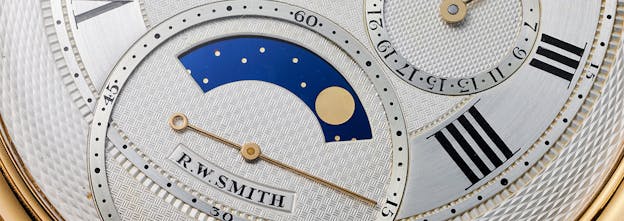Recommended Reading: The Art Of Engine Turning, With Revolution And Roger Smith
Real engine turning is time and labor intensive, but results can’t be achieved any other way.
Guilloché patterns can be seen on watches from a very wide range of prices, and the term is used somewhat generically in the industry to describe any pattern of small, repeating, spiral or geometric motifs engraved or stamped onto a dial or case. Unlike many horological fine finishing and engraving techniques, guilloché is purely decorative, although the use of different patterns on different sections of the dial can actually enhance legibility to some degree. Guilloché can be executed in several different ways; the least expensive is stamping, in which a die is use to make an impression on a metal dial, and you can also produce guilloché patterns with CNC machines as well. And of course, guilloché is, with good reason, strongly identified with the work of Breguet, a tradition which the brand has carried on down to the present day.

The traditional – “true” guilloché, if you like – is produced using a rose engine lathe or a straight line engine. In an article from Revolution, editor Cheryl Chia takes a very deep dive into the history and technical aspects of guilloché engraving, including notes on how to distinguish between guilloché produced by a rose engine lathe, and guilloché-like patterns produced by other means. She writes in part:
“Machined and stamped guilloché that attempt to replicate the effect of true engine turning have become prevalent in watchmaking today. It is increasingly difficult to distinguish between them yet it remains possible. Kari Voutilainen explains, ‘Handcrafted engine turning involves cutting metal using a tool, which results in a sharp surface, with sharp grooves at the bottom. In contrast, CNC machining utilizes a tool that is turning, leaving distinct milling marks, while stamping involves material deformation which doesn’t produce a sharp surface.”

The story takes you through every step of the process of making a guilloché dial, with an introduction to the history of guilloché and its larger context in the decorative arts, and an intro to the rose engine, preparation of the dial, the actual engraving process (which is done by hand, with one hand controlling the depth of the cutting tool and the other, the rotation of the workpiece) and finally, how a guilloché pattern-engraved dial is finished, in order to produce a clean surface that shows off the guilloché properly.
If you are interested in finding out just why guilloché is held in high respect and why it’s so labor intensive, I can think of no better place to go than Roger Smith’s series of videos on using a rose engine to engrave a watch dial (there is also a separate series on the use of a straight line engine).

The work requires, as does most watchmaking, painstaking attention to detail, and any mistakes during the process will tend to be immediately visible to the naked eye. Smith shows the entire process, including setting up the rose engine, checking the cutting head for sharpness, placing and centering the workpiece, and on and on. Here’s the first video in the series, just to get you started (and if you have not had a chance to see all of Smith’s watchmaking process videos, I can’t recommend them highly enough, for both clarity and comprehensiveness).
Both the article and the videos provide invaluable context for judging value added in a wristwatch. What’s true of guilloché is also true of movement finishing – there are automated and semi-automated techniques for producing different types of decorative and fine movement finishing, and finally there are purely manual methods. Each has its place – hand-finishing and decorating is enormous value added but it is costly and time consuming. Understanding what goes into some of these techniques can give enthusiasts much-needed context for setting realistic expecations, and evaluating watches across the entire cost spectrum as well.

